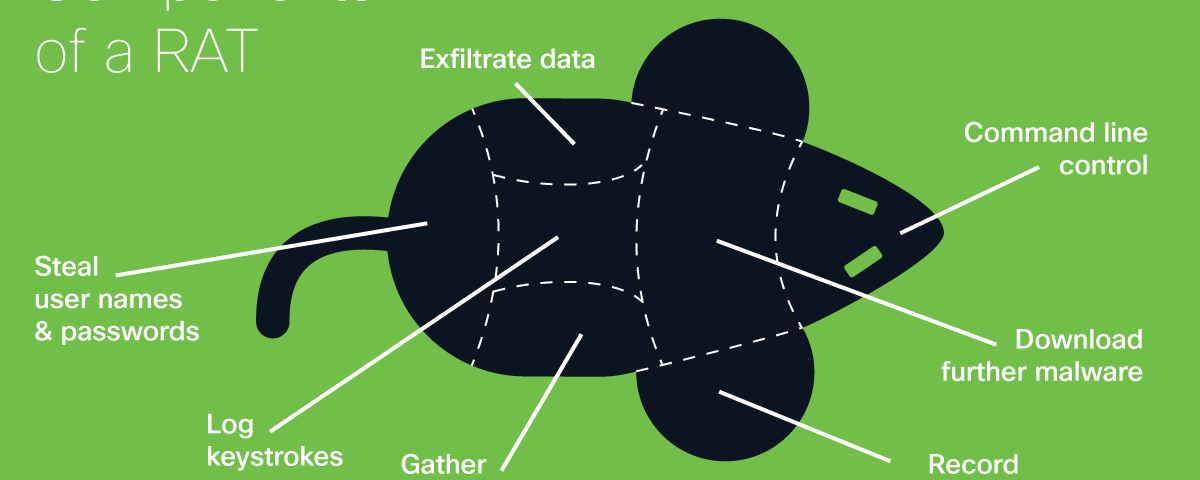
NetApp Reinvents the Customer Experience for the Hybrid Multicloud
October 30, 2019The commoditization of mobile espionage software
October 31, 2019Remote Access Trojans

You’re working for a high-profile technology company, close to releasing a market-changing product to the public. It’s a highly contested space, with many competitors, both domestic and international. There’s also a lot of buzz in the media and online speculation on the scope and impact your new product will have. And it goes without question that customers are keen to know more about the upcoming game-changer.
Your goal is to keep the secrets under wraps until the public announcement. Unfortunately, your surprise is about to be spoiled. It happens sometimes, as much as we work to prevent it—from accidental embargo slips to insider leaks. But in this case, it’s arguably the worst-case scenario: Your company has been breached and information about the product was stolen.
It’s unfortunate, but such breaches are not an uncommon occurrence—it’s something security professionals are far too familiar with. They occur across sectors, yet the way the data is stolen often includes familiar patterns. There are plenty of possible suspects, and untangling their motives is difficult. But in this cybersecurity game of “Clue,” we’re less concerned if it were Mrs. Peacock or Professor Plum. We want to know what the weapon was and how to prevent future murders.
There are a variety of useful weapons in an attacker’s arsenal. Downloaders, administration tools, and infostealers all often play a part in such an attack. But the go-to tool in many scenarios like this today are remote access trojans, often referred to as a “RATs.”
The anatomy of a RAT
A RAT is a swiss army knife of sorts. Distributed through familiar vectors, such as malicious downloads and email attachments, many RATs include all the weapons mention above, and more, making it easier for an attacker to leverage each component when carrying out an attack. In short, a RAT consolidates a number of tools into one package.
There is a lot of variation from RAT to RAT. Some are generalist tools, meant to be used across a variety of attack scenarios. Others are highly tailored to a specific attack. Some RATs use predetermined proxies to help mask an attacker’s ultimate location. Other RATs may leverage command-and-control (C2) infrastructure to do the same.

While the functionality and infrastructure used by a given RAT will differ, what follows are common features found within many RATs. To illustrate an attack, let’s take it back to our tech company breach, showing how an attacker can leverage a RAT to gain access to, and steal, sensitive files on your upcoming product.
Gather system information
The attacker managed to breach the defenses in your company using a phishing email that included a link to the RAT. However, that doesn’t mean that they will immediately know where they are on the network. They’ll naturally want to learn more about the computer they compromised. Is it an administrative assistant’s desktop, a laptop belonging to finance, or a web server? Performing reconnaissance on the system helps the attacker learn how deep into an organization they have penetrated, if they need to move laterally, or if they’re reached their intended target. Some reconnaissance tools even allow an attacker to scan other systems, gathering information about them.
Steal usernames and passwords
The attacker got onto one machine, but it wasn’t the intended target. They’d compromised a computer belonging to someone in the engineering group, but the materials they were after resided on a shared server. To move laterally, they may want to try searching for login credentials on the system they’ve already compromised. Many RATs include the ability to scrape saved and cached passwords, and once the usernames and passwords are in hand, the attacker can attempt to log into the shared server.
Log keystrokes
The attacker scanned the compromised computer looking for the login credentials, but no luck. Good news? Yes, but it’s only a minor setback. Many RATs include information-stealing components like keyloggers, meaning all the attacker has to do is enable it, and wait for the user of the compromised system to log into the shared server. When they enter login credentials, the attacker can capture them, and later attempt to log into the server themselves.
Download further malware
The attacker was able to obtain login credentials; however, their attempt to log in failed. (Perhaps your company uses multi-factor authentication?) To get to that shared engineering server, the attacker is going to have to call in reinforcements. They’ve identified a vulnerability on the shared server, and they need an attack toolkit to exploit it and gain access. Given how networks vary widely, many RATS include the ability to download further tools to assist them in gaining further access. In this case, the RAT operates like a downloader, pulling down an attack toolkit that allows the attacker to progress.
Accessing and uploading files
The attacker managed to gain access to the shared server, traversed its directory structure, and located documents that outline your new product’s features. The next step is to exfiltrate those files. Most RATs contain the ability to upload files to a predetermined location. This is often done with help of a proxy or through a C2 infrastructure, thus covering the attacker’s tracks as they steal the documents in question.
Recording audio, video, and taking screenshots
There may be times that an attacker isn’t satisfied with simply stealing design docs. Perhaps they obtained a slide deck, but it lacks context in certain slides. In order to learn more, they might want to return their attention to the initially compromised computer and have the RAT to record audio and/or video. The RAT might overhear the engineer speaking to a coworker or capture a video of a presentation meeting that discusses the product. RATs can often take screenshots as well, capturing critical documents on display.
Other uses
This is just one scenario where a RAT could be used end-to-end in an attack. RATs can be used in other situations as well. For instance, what if an attacker is hoping to exfiltrate financial data? A RAT can be leveraged to scrape banking details from a compromised computer or collect credit card numbers using a keylogger.
What’s important to highlight is that most RATs provide command line access to the systems that have been compromised. If adequate administrative rights are gained on these computers, an attacker can use a RAT to do just about anything that he or she desires.
Notable RATs
RATs have been around for a long time, and many prominent RATs have come and gone. Some recent RATs that have been prevalent on the threat landscape include Orcus RAT and RevengeRAT, which have been used by a variety of threat actors. Another commonly seen RAT is ExileRAT, which has been used in attacks with possible espionage-related motives, and shares a C2 infrastructure with the LuckyCat family of threats.
Not all RATs are built from the ground up either. Some are semi-legitimate tools, repurposed or reconfigured for malicious use. Two such examples include Imminent RAT and Remcos.
There are a number of attack groups monitored by Talos Intelligence that use RATs in their malicious campaigns. The SWEED threat actor often used Agent Tesla, the Panda threat actor has been seen dropping Gh0st RAT, and the Tortoiseshell group, who was recently caught scamming veterans, uses a RAT called IvizTech.
To catch a RAT
So the attacker managed to get into your network and obtain your product plans this time. How do you prevent them from doing it next time?
Fortunately, there isn’t anything particularly special about the way a RAT gets onto a system. They’re distributed in much the same way as other types of malware: they’re sent by email, dropped by droppers, set up as the payloads for exploit kits, along with other common attack vectors. Consider the following:
- A good endpoint protection application is very useful in protecting against RATs. AMP for Endpoints blocks malware at point of entry, then detects, contains, and remediates advanced threats.
- Monitoring network traffic for unauthorized activity is also important. Cisco Stealthwatch is the most comprehensive visibility and network traffic security analytics solution that uses enterprise telemetry from the existing network infrastructure.
- Many RATs encrypt their traffic, as we discussed in last month’s Threat of the Month blog, so be sure you can monitor such traffic as well. Encrypted Traffic Analytics provides insight into threats in encrypted traffic, without the need for decryption, using network analytics and machine learning.
- Being able to connect to C2 domains is vital for many RATs to function. Blocking known malicious domains can go a long way in stopping a RAT in its tracks. Cisco Umbrella uses DNS to stop threats over all ports and protocols—even direct-to-IP connections—preventing connections to attacker’s servers.
- Multi-factor authentication products can prevent an attacker from logging into a system if they manage to obtain login credentials. Verify users’ identities with applications such as Cisco Duo.
- A good email security solution, as well as a strong network perimeter, will help to ensure that RATs are blocked outright. Cisco Email Security is your best defense against such attacks via email, while Cisco’s Next-Generation Firewall can stop attacks at the network boundaries.
- A web security appliance with data loss prevention (DLP) features will also assist in cases where a RAT gets in and is attempting to steal sensitive information through the network. The Cisco and Digital Guardian DLP solution is a high-performance, comprehensive security solution for data in motion.
Enjoyed reading this Threat of the Month? Subscribe to the Threat of the Month blog series and get alerted when new blogs are published.

